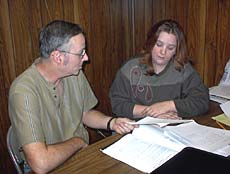|
"We have heard that Governor
Blagojevich is considering opening up 40 beds in one of the
buildings and bringing back some residents," state Sen. Larry Bomke,
R-Springfield, told the Lincoln Daily News on Tuesday. He
said officials are considering the move because of overcrowding at
other state facilities.
Bomke, who supported keeping LDC open
last year when former Gov. George Ryan and the Department of Human
Services succeeded in closing it, said he had been in touch with
Gov. Blagojevich's office, asking the new governor to meet with him
and other officials to talk about reopening LDC. The other state
officials who represent Logan County, Sen. Bill Brady of Bloomington
and state Reps. Bill Mitchell of Forsythe and Rich Brauer of
Petersburg, also supported keeping LDC operating.

Bomke said he had not yet met with the
new governor but applauded him for considering keeping his promise
to reopen LDC. "It is refreshing to have the new governor live up to
his campaign commitment," Bomke said.
"These buildings are in pristine
condition," he added. "It makes much more sense to reopen them
rather than build new facilities."
Bomke said he had heard that it was
going to cost $2 million to reopen a building to house 40 residents,
and he thought that figure was too high. He said he had been in
touch with former state Sen. Robert Madigan of Lincoln, and Madigan
was going to talk to people "more familiar with this type of thing
and get a more realistic cost."
Madigan, who was recently appointed
legislative liaison for the Lincoln/Logan Chamber of Commerce, also
confirmed that the new governor had sent a team to Lincoln to look
at reopening a building.
[to top of second column in
this article] |

"On behalf of the chamber of commerce,
we're encouraged by the fact that the new administration is looking
at reopening LDC," he said.
However, Reginald Marsh, spokesman for
the Department of Human Services, which oversees the state-operated
facilities for the developmentally disabled, said his office does
not know of any plans to reopen part of LDC.
"We have not been approached by the
governor's office yet, but that may change," he said. Gov.
Blagojevich has appointed a new director for DHS, Carol J. Adams of
Chicago. She will replace present director Linda Renee Baker on Feb.
18, Marsh said.
Members of the local chapter of the
American Federation of State, County and Municipal Employees, who
represent most of the former LDC employees, said they, too, have
heard that other state facilities are now overcrowded. When Gov.
Ryan closed LDC, some of LDC's 375 residents went into community
homes, but many more were transferred to other large state
facilities.
Local 425 president Don Todd said he
has also talked to at least half a dozen parents who want their
loved ones to come back to LDC. The LDC parents' association was one
of the strongest supporters of keeping the facility open.
Todd said he would estimate that if 40
residents return, the facility would need roughly 100 employees.
Former LDC employees who are still without work would be the first
to be called back.
There are
about 200 former LDC employees in the area who are unemployed or
underemployed, AFSCME officials said, and many would be happy for
the chance to come back to work for LDC.
[Joan Crabb]

|
|
On that date, the last 435 workers who
belonged to the American Federation of State, County and Municipal
Employees said goodbye to their workplace. They had already said
goodbye, often tearfully, to the residents they had served for so
many years.
The previous April, 32 AFSCME employees
had been laid off, bringing the number to 467 who no longer had jobs
working for LDC.
So where are they now?
Two of these former employees, Kim
Dennison and Charles Sanders, are working at the union office in
Keokuk Village on Chicago Street. They have been hired by the
Illinois AFL-CIO as peer outreach counselors to help unemployed
union members look for jobs, deal with insurance and retirement
technicalities, sign up for unemployment compensation, and offer
whatever other assistance they can. With the help of former Local
425 president Don Todd and consultant Dan Senters, Dennison and
Sanders have compiled some numbers.

[Photos by Joan Crabb]
[Peer
counselor Kim Dennison, center, pulls up job listings on the
computer to help former LDC employees Kim Morris, left, and Bob
Benedict.]
About 110 of the 467 former AFSCME
workers have retired, some taking the early retirement option that
was offered by the state of Illinois until Dec. 31 last year.
Of the 357 left, at least 53 got jobs
with the state -- some in other state-operated facilities for the
developmentally disabled; some in other capacities with DHS, which
operates all the state facilities for the developmentally disabled;
and some with different state agencies. The closest state-operated
facility is in Jacksonville, and a few have taken jobs there;
others, like Carl Twente, have had to move from the area. Twente
took a job at Choate, in the town of Anna in southern Illinois.
Of the 250 former employees left,
Dennison and Sanders said they know of 34 who got full-time jobs
working for employers other than the state and another 20 who later
got other jobs with the state.
That leaves approximately 250 still
unemployed. Dennison said at least 31 of those are enrolled in one
of two training programs to help them qualify for other jobs. One
program is the Workforce Investment Act, better known as WIA, a
federal program that helps train people for jobs such as licensed
practical nurse, medical assistant and computer technologist. WIA
pays up to $3,000 for tuition, books, day care and other expenses.
The other option is Upward Mobility, a state program that helps pay
for college classes that count toward approved degrees in fields
such as psychology, nursing, counseling and human development.

There are still about 219 former LDC
employees who haven't found suitable jobs, and most of them have
been in the union office at one time or another, Sanders said. He
estimates that one-third of them have low-paying jobs, often part
time, working in nursing homes, retail sales and food service,
including fast-food restaurants. Many are working in Community
Integrated Living Arrangements, the group homes for the
developmentally disabled located in the area, but these CILAs,
besides paying lower wages, almost never offer the health insurance
and retirement benefits that LDC provided its employees.
For example, one former LDC employee,
who was at the lowest level as a technician at LDC, made $11 an hour
there and had benefits. She went to work in a CILA, where she
started at $7.65 an hour. She is now making $8.25 an hour but still
has no benefits, including no health insurance for herself or her
child.
[to top of second column in
this article] |

Health insurance is a major reason the
search for a new job is becoming crucial for many former LDC
workers. State workers get a six-month extension of their health
coverage when they are laid off. Those few laid off in April who
didn't get other state jobs have already seen their health benefits
disappear, but many more were laid off in August, and their benefits
will run out at the end of February.
Former state employees do have the
option of keeping insurance for another 18 months, if they can
afford it. This program, the Combined Omnibus Budget Reconciliation
Act, or COBRA, allows state workers who have been laid off to buy
insurance that covers pre-existing conditions. Most of the health
insurance they could buy otherwise would exclude coverage for a
health problem a family member already has.
COBRA, however, is expensive. Sanders
said the cost for a family of four would run about $580 a month and
for just one person, more than $300.
For a few former LDC workers, those let
go in April, unemployment compensation will also run out soon, the
end of January or later, depending on how much vacation or sick time
the employee had left when he or she was laid off. These workers got
the regular 26 weeks of benefits, plus the 13-week extension granted
by President George Bush, for a total of 39 weeks of unemployment
compensation. Those let go in August, who also got a 13-week
extension, may be collecting unemployment until June or perhaps
later.
Because of the extension of
unemployment and the continued health benefits, former employees say
the Lincoln community has not yet felt the full impact of LDC's
closure.
"It hasn't been six months since most
of us were laid off," says Diane Sizemore, a former employee who is
still job hunting. "Soon everybody will run out of health insurance.
Some will also run out of unemployment benefits or are in low-paying
jobs."

[Charles
Sanders, peer counselor, works with Diane Sizemore looking for job
listings.]
Sanders agrees that the worst is yet to
come. "Unemployment is enough to keep some people afloat, but when
they can only get jobs paying $7 a hour, that's not going to be
enough," he said. He already knows of three former employees who are
in the process of losing their homes.
"Expect to see more people lose their
homes if they go to the doctor and run up a huge medical bill, or if
something happens to their car," said Kim Morris, another former
employee.
Kim and Diane, along with many others,
are still searching for jobs that can give them some of the
security, not to mention the satisfaction and the feeling of helping
others, that they found at LDC.
A ray of
hope that some of these unemployed workers might be able to return
surfaced this week when an area television station aired the news
that Gov. Rod Blagojevich had sent a team to LDC to look at the
possibility of reopening a section to house 40 residents. No
definite plans have yet been announced, but local AFSCME members and
political leaders are heartened by the news. Todd said the former
workers who are still unemployed would be the first to be rehired.
[Joan Crabb]
[Click here to read "Job search becoming crucial
for many LDC workers."]

|